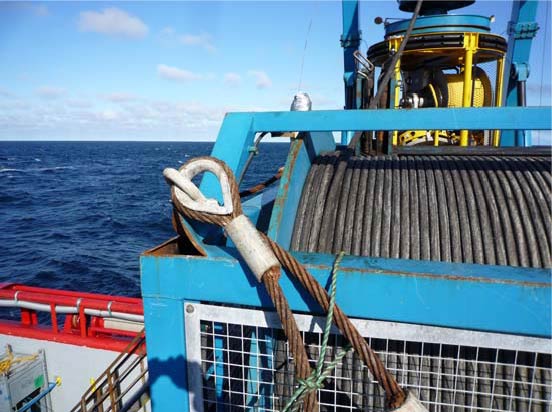Failure of lifting padeye
A member has reported a near miss in which a member of an ROV team spotted that one padeye on the tether management system winch was at an unusual angle. After closer inspection by the ROV pilot technician it became clear that the padeye had peeled away from the box section of the winch.
Following investigation it was concluded that this was likely to have happened during a recent mobilisation and had gone unnoticed for some weeks. The shift supervisor was informed, who brought the matter up in the daily meeting the next morning.
The cause of the incident is thought to be incorrect design. The 30mm thick padeye is welded directly to the top of a box section made from 5mm thick steel. The load on the padeye goes directly into the unreinforced top surface of the box section. Under repeated loading the padeye had peeled back the top surface of the box section as shown in the photograph.

The following conclusions were drawn:
- When hiring such equipment it can be taken for granted that the equipment has been designed correctly particularly when the equipment is certified. This incident shows that certification is no guarantee that equipment is correctly designed or has been handled correctly;
- Personnel involved in lifting operations must always check the condition of the lifting lugs/padeyes and slings prior to and immediately after use. In this case the damaged padeye was not noticed until some days after the damage was caused;
- All equipment subject to lifting must be treated with caution, particularly equipment that is repeatedly mobilised;
- During lifting operations always be prepared for the possibility that the load could drop or an object could fall off. The safety rule stating that personnel are not to go under the load, not to lift the load over the top of personnel and to keep a safe distance at all times should be reinforced.
Safety Event
Published: 3 December 2008
Download: IMCA SF 17/08
IMCA Safety Flashes
Submit a Report
IMCA Safety Flashes summarise key safety matters and incidents, allowing lessons to be more easily learnt for the benefit of all. The effectiveness of the IMCA Safety Flash system depends on Members sharing information and so avoiding repeat incidents. Please consider adding safetyreports@imca-int.com to your internal distribution list for safety alerts or manually submitting information on incidents you consider may be relevant. All information is anonymised or sanitised, as appropriate.
IMCA’s store terms and conditions (https://www.imca-int.com/legal-notices/terms/) apply to all downloads from IMCA’s website, including this document.
IMCA makes every effort to ensure the accuracy and reliability of the data contained in the documents it publishes, but IMCA shall not be liable for any guidance and/or recommendation and/or statement herein contained. The information contained in this document does not fulfil or replace any individual’s or Member's legal, regulatory or other duties or obligations in respect of their operations. Individuals and Members remain solely responsible for the safe, lawful and proper conduct of their operations.
